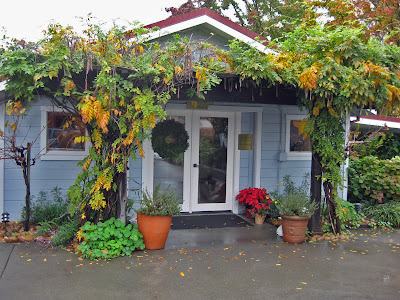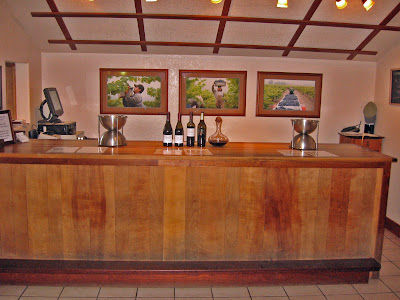 |
| "We are all mortal until the first kiss or the second glass of wine." |
Smith-Madrone Winery was founded in 1971 by Stuart Smith,
who is the managing partner, vineyard manager, and enologist. His brother, Charles F. Smith III ,
is the winemaker. The two brothers
performed a very Jungian feat Jung's self-made stone house by building the winery themselves from stones and
wood on their property. Their first
vintage was in 1977. I think of the
Smith Brothers as two pleasant wine-wizards disguised as mountain men who have spent years of their
life up on Spring Mountain
 |
| The part of the lab they let you see. |
Smith-Madrone vineyard is up on Spring
Mountain St.
Helena Napa
Valley
 |
| Just a diversion from their mysterious cellar. |
Although there was no vineyard on the 200 acre ranch when
the Smith brothers arrived, they did find old grape stakes and evidence that
there had been a vineyard there between the 1880s and Prohibition. The estate
had previously been planted with grapes by George W. Cook who purchased the
land in 1884. He used Chinese laborers to clear the land back then and there
are still the remains of a covered wagon on one of the old roads near the
estate that connects them with Stony Hill Vineyards to the east. Madrone in the
winery name refers to the evergreen Madrone trees that are on the ranch. They
also have twenty-two olive trees that are over 120 years old. On my next visit
I plan to ask them why they are not named "Smith-Olive Winery and
Vineyards," or, better yet, "Smith-Olive-Tesla Winery, Vineyards and
Secret Cellar."
 |
| Possible Big Foot (Yeti) burial grounds |
The entire estate is dry farmed (farmed without irrigation
or water.) Eastern exposed slopes are
used for Riesling, southern and western slopes have Cabernet Sauvignon and the
coolest, most north facing vineyards have Chardonnay. The initial grapes were planted on their own
rootstock. They produce about 4,000 cases a year from their 34 acres of
cultivated land. After an unsuccessful
attempt to produce Pinot Noir they abandoned the varietal and in 1989 they
grafted Chardonnay grapes on to the rootstock for the PN and no longer grow
that varietal. Was the Chardonnay
grafted to Pinot Noir rootstock? Another
question to ask when I revisit them. 6.25 acres are devoted to Riesling, 10.25
to Chardonnay, 13 to Cabernet Sauvignon, 3.75 to Merlot and one acre to
Cabernet Franc. They use barrel
fermentation, sur lie aging, open top fermentations, and other winemaking
techniques that require much hand labor.
They also may or may not employ the scientific genius of the famous scientist,Tesla, in their
endeavors.
What I love about
Smith-Madrone Winery is that they are totally genuine, the real thing,
if you will. Honest, no pretensions,
devoted to truth in a down to earth way that is not just admirable but
inspiring. They also happen to make great
wines, very unique with their own terroir, extremely well priced, etc. Their wines compare to the best in the world
and the owners seem like some of the finest people in the world. I think of Smith-Madrone as a triumph of the
human spirit. Meeting people like this
and tasting wine like this are part of what makes life worthwhile. Inspiring is an understatement.
Here is Smith-Madrone Winery Revisited. The best Western hemisphere Riesling I ever
tasted was grown and produced by this winery, the Smith-Madrone 2010 Riesling. One of my all time favorite Cabernet
Sauvignons was made by them, the 2005 Smith-Madrone Cabernet. (To which I can now add their 2007 and the
unbelievable Reserve.) They also made a very good 2008 Chardonnays and a my current favorite Napa Valley Chardonnay, the Smith-Madrone 2010 Chardonnay. Recently when we wanted to visit them just to
purchase more wines, they welcomed us and offered us some tastings. I did not have my notebook and was not
prepared to taste or take notes, so I can't
offer detailed tasting notes this time.
All I can do is relate to you what I remember to the best of my ability without notes.
First, Smith-Madrone now has a Cabernet Sauvignon
Reserve. It is the Smith-Madrone 2007 Cook's Flat Reserve. Smith-Madrone is one of the older wineries in Napa
Valley
To quote from their webpage, "The
Cook's Flat Reserve represents the very best of which we are capable in a given
year. It can only be made in small
quantities and will only be available when warranted by superior quality. It is the ultimate distillation of our
experience and expertise." It was aged in French oak for two years and
then bottled and stored for another three years prior to release. Retail is $200, and you will have to obtain
it directly from the winery. Their new reserve is superb, big but balanced,
with some very interesting Cabernet Franc adding its signature. Although it has
great fruit, it is definitely terroir driven; unique, complex and interesting;
it could not have been made anywhere else than on Spring
Mountain
The Smith-Madrone 2010
Chardonnay ($30) is exceptional in every way and now my favorite Napa
Valley Chardonnay. Somehow I missed
tasting their 2009 Chardonnay but did have the 2008, which I liked. But the 2010 is much better, more complex,
not as austere, with incredible varietal fruit.
I look forward to savoring a bottle and adding some detailed tasting
notes.
The Smith-Madrone
2007 Cabernet Sauvignon ($45) is much more approachable now than their
2005 was when I had several bottles early in 2012. (How did I miss tasting the
2006?) The 2005 was a big, powerful
mountain wine that needed to be paired with food to be fully appreciated. Twenty years in the cellar would do it good. Heck, it might handle 100 years. The 2007 has much more finesse, more typical
of the great 2007 vintage in Napa Valley. Again, I
look forward to sitting down and drinking some while taking tasting notes. It is very different than the 2005, but I
like it just as well, probably even better.
Here is my comment on the 2005 Cabernet attached as an addendum at the bottom of our report from our last visit: 2005 Cab
In my eagerness to taste the new reserve, the 2007 Cab
release and the new Chardonnay, I neglected to try the Smith-Madrone 2011 Riesling ($27),
but will add tasting notes after I try some. The Smith-Madrone 2010 Riesling was simply amazing. Please see my review here: A Riesling to die for
While we were there, Charlie happened to be experimenting
with some old wines that he found in their mysterious basement cellar which
frequently floods. (I don't know, but I
suspect they have secret scientific experimental equipment down there and
possibly a resident Big Foot.) Anyhow
Charlie found some of their really old Chardonnay and noticed that one year had
not turned brown. This was the 1984
Smith-Madrone Chardonnay. He offered us
a glass and this nearly 30 year old wine stored in a flooded cellar with Big
Foot hairs, tasted wonderful. So how
does one really old Chardonnay taste great and others not quite as old are
undrinkable? That is where I came up
with my Tesla hypothesis. I don't know
if it is an actual time travel machine they have but they have some strange
scientific equipment that can make a 30 year old Chardonnay still taste great. Maybe it is a machine that produces effects like the fountain of youth. Maybe that is why a Big Foot lives
there. Perhaps the Big Foot is Tesla in
disguise and he is in on all of this with them.
Is this why everybody knows the name Thomas Edison, but relatively few
know about Tesla, an even greater inventor and genius? Maybe he just disappeared up on Spring
Mountain
I'm sorry I did not have my notebook to take tasting notes
during our visit, but I will add them at a later date after I taste some of the
bottles we purchased. Other people's
tasting notes are pretty boring, however, so why don't you just go up there
yourself? Your own notes will be more
interesting, and nobody knows your individual tastes better than you do. Besides, you haven't lived if you love wine
and have not yet visited Smith-Madrone Winery.
Put it on your "bucket list." As with all Spring
Mountain
Addendum Flash
Release: Charlie Smith confessed
today that reports of a hairy beast inhabiting the Smith-Madrone Winery cellar
are, in fact, true. Stu recently went on a trip to Montana. Some people go there to hunt elk, but Stu had gone there to rescue an elk calf. He was too embarrassed to tell people that he had
fallen for the eyes of a young elk, so he hid it in the cellar, letting it out to graze at night. Charlie found out about it but is keeping it a secret to help Stu save face. When asked about the great scientist Tesla
also living there, Charlie replied, "No comment." We don't know if this story by Charlie is true or if it is a coverup for harboring a Big Foot or for providing a hideout for a famous scientist whom most people think is deceased. It could even be that the elk calf shares its quarters with Big Foot and Tesla.
Our first visit to Smith-Madrone may be viewed here: Smith-Madrone
Here is a special review of their Riesling: Riesling
Our first visit to Smith-Madrone may be viewed here: Smith-Madrone
Here is a special review of their Riesling: Riesling
Phone: (707) 963-2283
Date of visit: December 12, 2012









